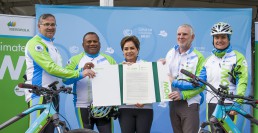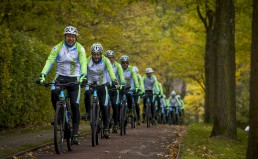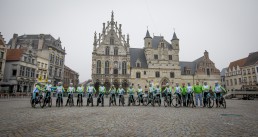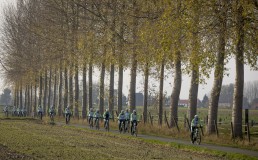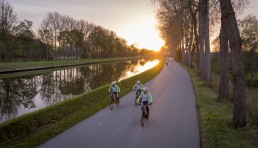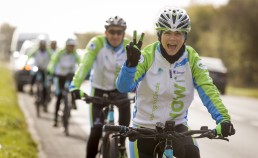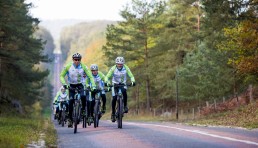Stage 7 SIMMERATH - BONN COP23
Germany welcomed us with rain and with roads full of climbs and descents.
But neither the weather nor the 1,150 m accumulated height could prevent us from bringing our Manifesto to the highest authorities of COP23, which opens its doors officially tomorrow.
At Bula Zone the numerous participants picking up their credentials have witnessed the arrival of our team, nineteen cyclists, among them Inia Seruiratu, Fiji’s High-level Climate Champion, Jochen Flasbarth, State Secretary at Ministry for Environment, Nature Conservation, Building and Nuclear Safety and Patricia Espinosa, Secretary General of the UN Framework Convention on Climante Change.
Today we have reached the almost 800 km of our journey for awareness and action against climate change. The Executive Secretary’s words, who joined the end of the leg and welcomed the cyclists at the entrance to COP23, could not be more appropriate.
“It is amazing to see so many people coming from Paris using low-emission electric bicycles. As the UN Climate Change process moves from Paris to Bonn and into the future, this should inspire us all to seek a path forward where our emissions are reduced, we embrace the technology that enables this shift and we raise awareness for the need for a deep transformation of societies. We all need to be moving for climate now – further, faster, together”
More images
Stage 6 URMOND - SIMMERATH. CLIMATE CHANGE MITIGATION
We are in the second to last stage of Moving for Climate NOW, a journey for the climate that is now reaching its destination. It is time now to recap on the different policies and tools that allow the achievement of the climate targets. And we have done so along the 104 km, reaching Germany and going through its mountains and landscape stained with wind farms.
In a simplified manner, there are 3 main types of climate policies: price or market instruments, command and control tools and other policies (information, awareness, education, etc.)
Market instruments allow for the incorporation of societal damage costs of CO2 emission to the price of goods and services that its originator does not pay for (“externality internalisation”). These instruments are increasingly important. In 2016, around 40 countries and 20 cities and regions had introduced a CO2 price. However, there is still a long way to go, as they only represent 13% of global emissions.
Command and control tools strive to act directly on the climate features of different processes, equipment, materials, etc. These types of tools, like building regulations, are especially useful to improve the economy’s energy efficiency. These policies are experiencing significant growth but their coverage is still low; almost 70% of final energy use is under no type of efficiency standard.
Thirdly, there is a heterogeneous group of measures within which actions towards more transparency and a better management of climate risks will be a central theme.
Given the complexity and relevance of climate change it is necessary to consider all these instruments and apply them in a coordinated manner, taking into account specific geographical characteristics in addition to incentives generated across the economy.
Our voices
“Climate change is here and we have to adapt to it. The earlier we do it the cheaper and better will be” Gonzalo Saénz de Miera. Iberdrola.
“All actors and sectors should already consider the fight against climate change in their strategies, projects and actions, both the adaptation measures needed to face the impacts of climate change and the options to reduce greenhouse gas emissions” Ana Pintó. OECC.
The direct impact of drought and floods on childhood is not evident at first sight, but 175 millions of children in the world could be affected by climate change in the next decade. Tiziana Trotta. Planeta Futuro
More information and quotes
The European Environment Agency reveals that weather and climate events caused losses above 450 billion euros in the 33 member countries of the European Economic Area during 1980-2016 and alerts about the need to prepare better to climate change consequences.
According to UNFCCC developing countries need dozens billion dollars per year to respond to present and future climate change impacts.
More images
Stage 5 BRUSSELS. URMOND ADAPTATION TO CLIMATE CHANGE
During the fifth stage of our trip we have crossed Mosa river to get to the Netherlands, reaching Urmond (Limburg region) for the night. The Netherlands has a large part of its territory (24%) under the sea-level, and without water barriers, 70% is vulnerable to floods from the sea or rivers. Densely populated cities like Rotterdam have more than 80% of their territory under the sea-level. This makes The Netherlands highly vulnerable to climate change impacts like rising sea-level and increased storms, which increase the risk of floods.
For the Dutch inaction is not an option and for years they have been taking adaptation to climate change very seriously, by adopting innovative and ambitious measures, becoming a world reference in this matter. Adaptation is inevitable. The cost of adopting measures towards adaptation is lower than the cost of inaction. And furthermore it can turn into an economic opportunity.
Being in The Netherlands we wanted to highlight the need to put adaptation at the same level as mitigation in the climate agenda. Climate change impacts are already a reality and all countries must take climate resiliency seriously.
In this sense, adaptation will have a central role in the next Climate Summit, COP23, chaired by Fiji, where financing adaptation measures for the most vulnerable nations are, among others, a priority topic. According to the UN Framework Convention on Climate Change developing countries need dozens billion dollars a year to respond to current and future climate impacts. Financing is key as climate change has the power to revert many of the achievements attained in economic and social development.
Our voices
“Climate change is here and we have to adapt to it. The earlier we do it the cheaper and better will be” Gonzalo Saénz de Miera. Iberdrola.
“All actors and sectors should already consider the fight against climate change in their strategies, projects and actions, both the adaptation measures needed to face the impacts of climate change and the options to reduce greenhouse gas emissions” Ana Pintó. OECC.
The direct impact of drought and floods on childhood is not evident at first sight, but 175 millions of children in the world could be affected by climate change in the next decade. Tiziana Trotta. Planeta Futuro
More information and quotes
The European Environment Agency reveals that weather and climate events caused losses above 450 billion euros in the 33 member countries of the European Economic Area during 1980-2016 and alerts about the need to prepare better to climate change consequences.
According to UNFCCC developing countries need dozens billion dollars per year to respond to present and future climate change impacts.
https://www.youtube.com/watch?v=JMNXPzwADQ0&feature=youtu.be
More images
Stage 4 BRUGES-BRUSSELS. AWARENESS, COMMUNICATION AND PARTNERSHIPS
Our expedition arrives today at its equator. The last kilometers of our stage have gone through the centre of Brussels, the agora of politics, the square of all of us. It is not a coincidence that Schuman Square, one of the fathers of the European Union, welcomes us in the end of our stage, moment which we have immortalized.
After the effort of these days, the fellowship, the sharing of knowledge, we take advantage of the fact that we are at the epicenter of European policies to debate and launch ideas on transversal issues: awareness raising, communication actions, education and partnerships.
In Brussels community feeling are breathed and this fact attracts glances which have different interests. Between them, whose like us: people who move to tackle climate change. The European Commission is examining cost-effective ways to make Europe's economy more climate-friendly and less energy-intensive. In particular, by 2050, the EU should have reduced its greenhouse gas emissions by 80%-95% compared to 1990 levels. In its policy, it expressly recognizes that all sectors need to contribute.
This point: the contribution of everyone, all people, all institutions, all agents is one of the pillars of Moving for Climate NOW and our Manifesto. To this end, it is necessary to have an impact on education, public awareness, communication and action policies.
But not just any action, an action based on partnerships, that can optimize results thanks to collaboration. Amina Mohammed, deputy secretary general of the United Nations, points out: "we have the opportunity to provide peace, prosperity and dignity for everyone on a healthy planet and we cannot fail, the task is difficult, but nothing is impossible when we work together in partnerships”.
The new 2030 Agenda framework, in which the Paris Accord and climate actions stand out, stipulates this change of paradigm in the way of operating, urging us to work in partnerships, which will be solid, inclusive and integrating. These can be sectoral, transversal, multistakeholder or public-private.
In the field of education the responsibility is also shared, as UNESCO points out in its recent Global Monitoring Report (GEM). It sees education as a shared responsibility of "governments, schools, teachers, parents and private agencies. A good education is the basis for improving our lives and sustainable development.
There is still no consensus as to what results education for sustainable development and education for global citizenship should achieve. Measuring scientific knowledge on climate change and the Earth can be an easy option, according to UNESCO.
But besides to the educational environments, it is essential to generalize these messages, to inform, to raise awareness and to engage. Until these topics appear on the journalists' agenda, citizen communication campaigns, political programs, professional training and business decisions.
The commitment to climate action has to be communicated, learned, but especially, performed. Calls to action can be found in the basic materials that the United Nations makes available to citizens. For example, in The Lazy People Guide to Saving the World[1]. And those who have already taken action can join the information stream about this by using the hashtag #globalgoals on their social networks.
If you already know that we are the last generation that can fight climate change, don't ignore it. Work for it, join in, vote for it... and tell about it.
[1] http://www.un.org/sustainabledevelopment/takeaction/
Our voices
“Moving for Climate combines emotion, commitment, effort and urgency in the cause. It deserves everyone to take part. Because the time has come when collaborating is more profitable than not doing it." Isabel Garro
“Communicating the low carbon transition is critical. How and who we talk to about climate changes matters enormously – these conversations serve to broaden the discussion, to include diverse voices and views and help make climate change real to everyone. Most importantly our communication can and must catalyse action." Siobhan Dunn
“I think it so important that people feel that climate change is their own problem and that very big corporations and companies attitudes change also before it gets too late, because today global warming is a big problem, but if our behavior does not change, it will be the only problem”. Juan Luis Cano
“I believe that the key to fighting climate change is to get the younger generations on board and to make them realize the gravity of our current situation and the part they have to play in it, as well as the fact that they have to deal with the repercussions”. Inka Vogt
“Anyone can make a difference for the environment, no matter their age, race or gender. It's easier now than ever before to get involved, or to get others involved”. Fabian Beveridge.
More information and quotes
The Global Goal 13, points out that we have to “improve education, awareness-raising and human and institutional capacity on climate change mitigation, adaptation, impact reduction and early warning”[i]
The target 17.17 in the 2030 Agenda of United Nations, encourages us to promote effective public, public-private and civil society partnerships, building on the experience and resourcing strategies of partnerships
Myworld, the survey of United Nations about the concerns of citizens around the world, has fast 10 million votes. The priority of climate change has less than 2 million votes. It's the least voted.
2015 PISA research del PISA de 2015 howed that 21.5 per cent of 15-year-olds in OECD countries were below the level of the minimum competencies on the issue “ Earth and Space”.
According to UNESCO, only 7% of countries include education for sustainable development in teacher training.
More images
Stage 3 ROUBAIX - BRUGES. INVESTMENT LOW – CARBON ECONOMY
In our third stage we have left France and continue our journey in Belgium. The first thing we have done is to get close to the coast in Oostende, in the Atlantic ocean. During the day we have seen some typical windmills that for years have been using wind energy for different functions. Today, wind energy is increasingly being used in our energy model, especially for power generation, where they already represent 25% of the global electricity mix. In spite of the large growth in clean energy investment, reaching the 2oC scenario requires and acceleration in the pace of investment. Renewable energy should reach more than 50% of the power mix by 2040 and additional investments are also needed in storage and infrastructure as well as in the decarbonisation of other sectors like transport, buildings, etc. Some studies estimate investment required for the next 15 years is slightly over 100 billion dollars.
Investing in a low-carbon economy is also an opportunity. Opportunity for employment, for new industries and competitiveness. Opportunity to improve energy security and resiliency. Basically, an opportunity for growth and development.
The other side of investment is financing, as every investment requires financial resources. Financing comes from diverse sources: general budgets, private investment that collects funds via financial products, multilateral funds defined within the UN Framework Convention on Climate Change.
The Paris Agreement establishes a target to reach 100 billion dollars annually in climate financing in 2020. This target can be reached maintaining current investment levels but requires clear policies, such as increasing public funds for financing climate action and the establishment of policies that facilitate private mobilisation, for example by applying the “polluter pays” principle.
Moreover, developed economies must collaborate also on capacity building of most vulnerable countries.
Reinforcing financial resources and tools will be one of the key COP23 action lines.
Our voices
“A well-functioning financial system is critical to support green infrastructure investment and encourage risk-sharing and transparency. The disclosure of climate risks in portfolios valued into the trillions of dollars is critical and increasingly gaining traction.” Geraldine Ang. OECD
“Renewables-based energy system is technologically possible, economically viable and socially desirable.” Elizabeth Press. IRENA
“The decarbonisation of the economy is viable thanks to the existence of technology already available at competitive prices, and it also generates numerous opportunities for employment and sustainable businesses.” Carlos Sallé. Iberdrola
“Last year renewables accounted for half of global electricity demand growth; in the next 5 years they’ll grow twice as much as coal and gas.” Luis Munuera. IEA
More information and quotes
According to OECD, investment required to remain below 2°C is USD 6.9 trillion per year over the next fifteen years for new infrastructure. Only a 10% increase relative to annual infrastructure investment needs before considering climate issues (USD 6.3 trillion).
IEA scenarios show renewables and energy efficiency get us three fourths of the way towards 2oC
More images
Stage 2 PERONNE - ROUBAIX. ENERGY TRANSITION
In our second stage of Moving for Climate NOW we have reached Roubaix, endpoint of the renowned bicycle road race Paris-Roubaix. For the last 25 km, of our 111 km journey, we have followed actual race track with its challenging cobblestones. The journey has mostly taken place in flat and rural land, making the ride quite peaceful and pleasant.
Our discussion has been focused on the importance to change our energy model, which is key for achieving a sustainable energy model, which contributes with two thirds of the total greenhouse-gas emissions.
It is urgent to take action to accelerate this transition and technological progress is making it easier. Decarbonising energy requires action in three areas 1) efficiency 2) electrification and 3) decarbonising the power sector with clean energies.
The impressive cost reduction in renewable power generation technologies, wind and solar, and batteries, which will make electric vehicles more competitive than conventional vehicles in a few years, reveal that these changes are desirable not only from an environmental point of view but they create a large economic opportunity which shall not be wasted. Those countries that first realise this opportunity will additionally align their economies with the main global tendency to fight against climate change.
Clean and sustainable energy has an additional benefit: reduction of air pollution. Urban citizens are very exposed to local pollution, since cities accumulate the largest concentration of pollutants and therefore, the largest impacts on health. Today, almost all citizens in Europe are above the limits established by the World Health Organisation, so it is urgent to implement corrective measures.
For this reason, cities worldwide are increasingly acting to have clean streets without pollution or CO2. And they do it individually or through important organisations. Moving for Climate NOW calls for the importance of having clean energy and clean air to breathe in cities. We pedal in this long route to show the viability of this mode of transport, healthy and environmentally friendly.
Our Voices
“Achieving more sustainable mobility based on sustainable modes of transport and the use of alternative fuels is key to the achievement of climate objectives and it also has other co-benefits such as reducing air pollution and improving health” Guillermo Martínez. OECC
“Decarbonizing the energy sector will require of course renewable energies and energy efficiency. But the absolutely first priority is reducing the amount of energy we use”. Pedro Linares. Universidad de Comillas
‘Energy efficiency is inextricably linked to climate and yet we don’t allocate nearly enough of our attention and resources to it– nearly half of the needed GHG emission reductions in the energy sector to reach the Paris Agreement goals are meant to come from energy efficiency! For that, significant scale up of investments and action is needed.’ Ailin Huang IPEEC
“The electric vehicle is an essential axis of the goals for transport decarbonisation”. Arturo Pérez de Lucía. AEDIVE
“Acting on climate has huge co-benefits for other SDG goals such as air pollution and energy access” Luis Munuera, International Energy Agency
More information and quotes
Energy sector represents two thirds of global GHG emissions.
IEA scenarios show renewables and energy efficiency get us three forths of the way towards 20C.
55% of total population lives in cities, consume 64% of primary energy and contribute 70% of all CO2 emissions.
https://www.youtube.com/watch?v=nH8MQ1KFKwg&feature=youtu.be
More images
Stage 1 PARIS – PERONNE. OCEANS AND NATURAL SYSTEMS
We start pedalling for climate action in Moving for Climate NOW! And we are doing so starting in Paris, a city full of symbolism while recalling the historical milestone that the Paris Agreement represents. Negotiations on its implementation will take place during the next Climate Summit COP23, which will take place in Bonn, our final destination, from November 6 to 17, 2017. This year the COP23 Presidency is chaired by Fiji and it will be a means to give visibility to the vulnerability of small island developing countries towards climate change, such as sea-level rise, and increase in the frequency and intensity of storms. The COP23 Presidency vision, well captured in its logo, wants to raise awareness on the uncertain future that climate change brings to these island territories and to the world’s coastal areas. Since the start of the 20th century sea-level at a worldwide level has already risen by 20 cm.
In Moving for Climate NOW we want to contribute to spread this message and to warn about how climate change, in addition to other human pressures such as pollution or overexploitation of resources, is aggravating our oceans situation and that of our natural ecosystems (sea water temperature, ocean acidification, wildfires, droughts, etc.) with substantial economic and social impacts, as have been observed in the last huricane events in the Atlantic. Island countries are especially vulnerable; in 2016 Cyclone Winston caused Fiji damages up to one third of its GDP.
After a cycling journey of 121 km to Peronne (Picardie region), where we have gone through vast croplands, stained with small forest areas, we have reflected upon the importance of promoting healthy ecosystems to palliate and combat climate change.
We must not forget that oceans as well as forests act as large carbon sinks and storages and as such are key to ensure equilibrium between CO2 emissions and the planet’s absorption capacity. Moreover they provide a range of goods and services (climate regulation, air and water quality, erosion control, soil fertilisation, pollination, etc) fundamental to sustain human activity like agriculture and tourism. For this reason, promoting increased awareness on the goods and services that natural systems provide and their link with climate change is key. The weaker the natural ecosystems become, the lower the capacity we will have to face changes in climate. And vice versa, a changing climate weakens natural ecosystems.
Our voices
"Vivimos en un planeta azul. Los océanos sustentan la vida en la Tierra y nuestro bienestar común. Producen la mitad del oxígeno que respiramos, regulan el clima y absorben CO2”. Sonia Castañeda. Fundación Biodiversidad
“Climate Change is an ethical issue; it implies questions of fairness and responsibility between generations, nations, individual and the rest of the nature” Gonzalo Saénz de Miera. Iberdrola.
“Sea-level rise, lack of rain, desertification, ... affects especially those families with lowest resources” Jorge Cattaneo. Ayuda en Acción.
More information and quotes
Damages sustained in Fiji during Cyclone Winston in 2016 were $1.4 billion, nearly one third of total GDP. COP23
El Índice Planeta Vivo 2016 revela que la población mundial de vertebrados disminuyó un 58% entre 1970 y 2012 debido a las actividades humanas. Prevé una disminución de hasta un 67% en tan solo medio siglo (en el periodo 1970-2020).

